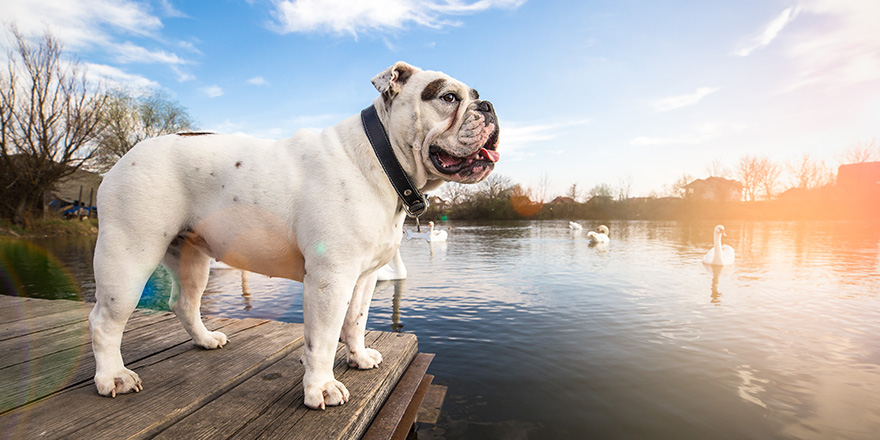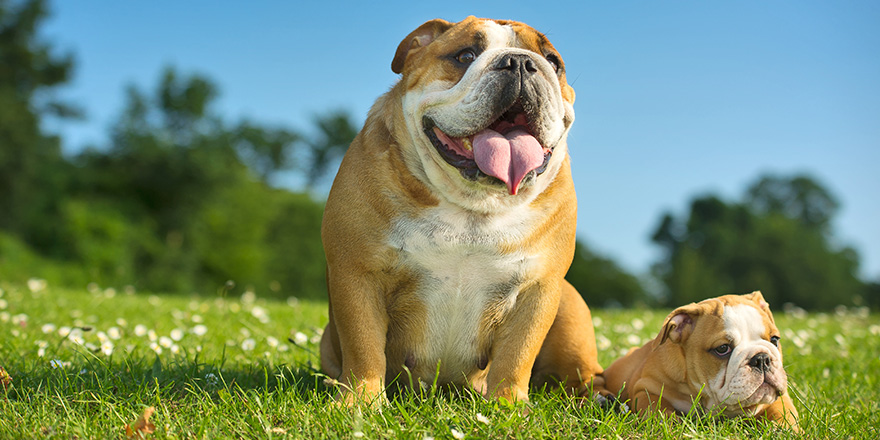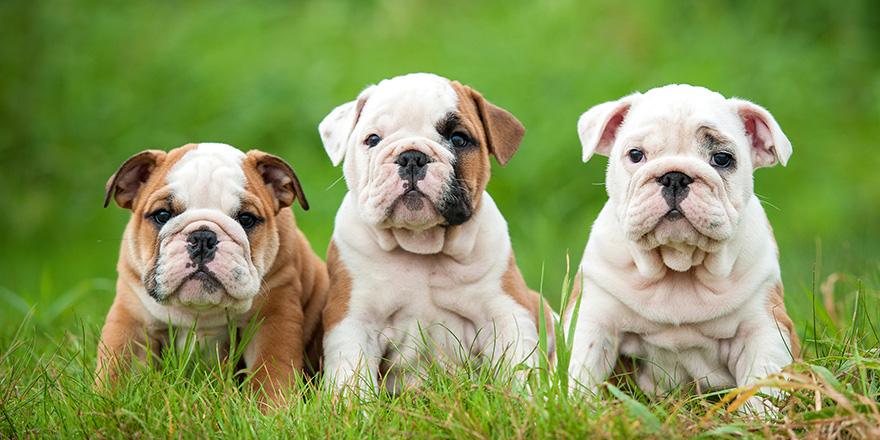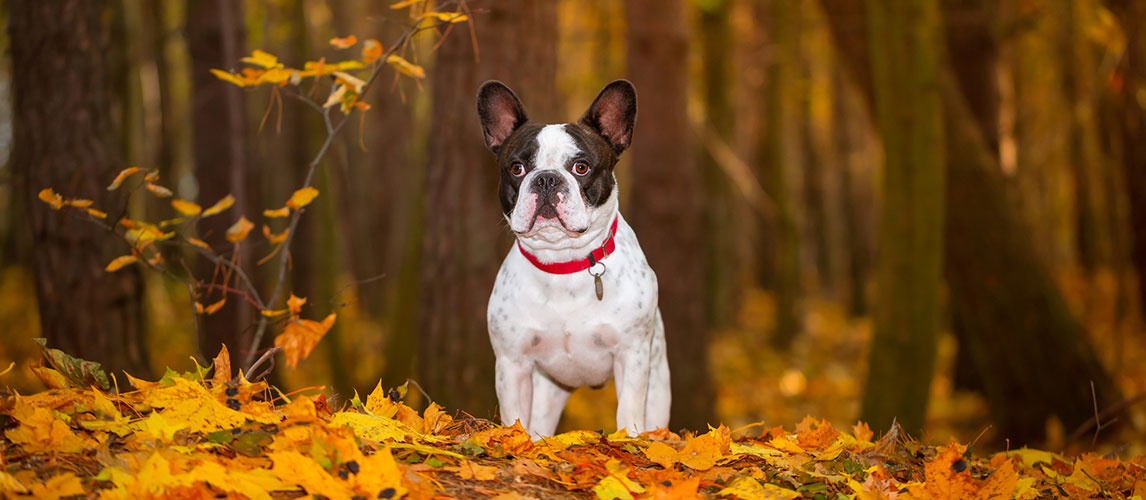The English Bulldog, also known as the British Bulldog, is a thick-set breed of dog that is muscular, yet belongs to the non-sporting category. Historically, these pups were used in bull-baiting, which gives these dogs a rather cruel origin story. Today, they are mostly used as guard dogs or adopted into families to be companions to young children and watch over them when they’re playing. We’d like to introduce you to this unique and friendly breed through our informational guide on English Bulldogs.
Breed Overview
| Dog Breed Group | Height | Weight | Life Expectancy |
|---|---|---|---|
| Non-sporting | 14 to 15 inches | 40 to 50 pounds | 8 to 10 years |
History of the English Bulldog

As we very quickly mentioned at the start of this guide, English Bulldogs were once used for the sport of bull-baiting. This was a professional sport where an audience would gather to bet money on the outcome of each “match”. It was the job of the English Bulldog and its fellows to try and pin a full-sized bull to the ground. Sometimes, a dog would be forced to try and complete this task alone, other times they would be in small teams or duos.
Back then, English Bulldogs were a little taller than the version of the breed we see today. They had more muscle, their jaws and bite were more powerful, and they were bred to be aggressive dogs. It was likely that their aggression was one of the only ways the dogs could survive the sport they were forced into.
English Bulldogs continued working the ring until bull-baiting was made illegal in 1835. However, this almost caused the extinction of the entire breed, which is why our modern English Bulldogs look so different to the Old English Bulldogs. People admired the strength of the breed and didn’t want to see them lost to time, so many breeders attempted to bring the breed back, but they chose dogs with even tempers and docile natures to continue breeding.
In 1996, the new version of the English Bulldog became recognized by the American Kennel Club. The dog, obviously, originated in England, UK, and it came to symbolize the country and her people in a number of ways. Funnily enough, a number of organizations in the U.S. use the English Bulldog as their mascot, despite the breed’s British origins.
Breed Information
Breed Appearance
Although the Bulldog breed isn’t a particularly large dog, they’re extremely strong. As a mid-sized dog, you don’t expect them to be as heavy as they are, but their average weight of 40 to 50 pounds is down to their huge amount of muscle mass. They’re a blocky-shaped pup and though they are a generally healthy breed, they can be prone to various health conditions that we’ll get into later on in this guide.
Although early Bulldogs were originally bred for sport, today’s modern Bulldog takes more pride in protecting their family or taking part in competitive dog sports – such as obedience and agility competitions. Their strong body makes them a formidable opponent for other breeds to go up against in a race. The breed standard of these dogs has a very particular appearance that is popular at dog shows, too.
According to the American Kennel Club, the overall breed standard for today’s Bulldog is as follows:
- Of medium size, with a smooth coat.
- A low-swing body with a large, short-faced head and wide shoulders.
- Kind disposition, not vicious or aggressive in any way. The dog should be dignified and courageous.
- Mature/older dogs should be around 50 pounds in weight, though female dogs should be around 40 pounds.
- Ears should be set high on their head, with the “rose ear” being the most desirable form for this dog breed.
Eyes
- As seen from the front, eyes should be low down in the Bulldog’s face, and far away from their ears.
- Round eyes only, they shouldn’t be sunk into the skill or bulging out from it like Pitbull breeds.
- Eyes should be dark in color, blue or green eyes result in disqualification from the standard requirements of the breed.
Coat
- Finely textured, smooth, and glossy. They should have a short-haired coat.
- Soft and loose skin, with a face covered in heavy wrinkles.
- A uniform coat color, which may be red, white, fawn, or fallow.
- Acceptable marking colors include brindle, piebald, ticking, black masks, black tipping, or a small amount of solid black in piebalds.
- Other coat colors or markings will result in disqualification, and any merle pattern on the Bulldog’s coat is also grounds for disqualification.
AKC scoring for the Bulldog breed is heavily weighted towards the appearance of the dog’s head, particularly their nose. Bown or liver-toned noses also result in disqualification for a dog from this breed.
Fun Facts
- It’s often said that Prime Minister Winston Churchill shared some characteristics with the English Bulldog.
- President Calvin Coolidge had an English Bulldog named Boston Beans.
- Yale University was the first university to adopt a doggy mascot, who was a Bulldog they named Handsome Dan.
- There have been a number of institutions and organizations that use a Bulldog mascot.
- A Bulldog from Lima, Peru, set the world record for the longest tunnel traveled through by a dog skateboarder in 2005. His name was Otto.
- During the Second World War, there were French postcards that showed a British Bulldog tearing up a Nazi flag.
Personality
Small dogs like this are prone to having one of two personalities – either aggressive or incredibly friendly. The interesting thing about these dogs is that they have, historically, been both. With their stocky legs and strong appearance, even Bulldog puppies can seem like a lot to handle, but they are actually some of the sweetest and most caring dogs that you’ll ever have the pleasure to meet. They look scary, but all Bulldog owners will tell you that owning a Bulldog puppy and watching them grow into mature females or male dogs is an absolute pleasure.
Purebred dogs from this breed should retain the same compassionate personality traits that other dogs from their group have. After the debacle that was bulls versus Bulldogs in the 19th century, these bull baiters were transformed into a different kind of dog with a slightly new breed name. The English Bulldog may have a massive head and a few health concerns, but they’re a highly trainable dog with a decent amount of energy.
They don’t bark much, so they’re perfect for apartment living or for families that have specific living conditions and allowances for dogs. Older Bulldogs get more and more relaxed as they age, slowly becoming couch potatoes who are happy to lay about like all other dog breeds who reach their senior years.
If you’re looking for an affectionate family member who will look after your young children and get along with other dogs in your home, a Bulldog is an excellent choice.

Health, Care & Grooming
Health Conditions
We’ve briefly mentioned that the English Bulldog breed is prone to a couple of health conditions. The major issue with this breed comes from their overall stature and the shape of their muzzle. Their build gives them joint issues, which means that this breed is prone to conditions like arthritis, hip dysplasia, and other health problems. While the shape of their face means that you’ll find that Bulldogs wheeze often or have more serious breathing conditions.
Dogs with a short nose, like the Bulldog, can have a condition called Brachycephalic Syndrome. This affects almost all dogs with short noses because they have the same amount of tissue in their nose and throat as dogs with longer noses, but the tissue is cramped up in a tight space with nowhere for it to go. This results in the breed having a soft palate that is too long, forcing it to hang down into their airway. Dogs with breathing issues caused by Brachycephalic Syndrome are less likely to tolerate heat because they can’t regulate their own breathing, which makes them pant faster while trying to cool down. You may often see their tongues hanging out of their mouth during these times, which is a sign that you need to get your pup to a cooler area before they get heatstroke.
The average lifespan of Bulldogs is shorter than other dog breeds because of their numerous health issues. They are prone to weight gain and overeating, especially when their food intake isn’t being properly monitored, and most Bulldogs will end up with a vet to prescribe medication several times throughout their life.
That’s not to say that it’s impossible for a Bulldog to live a good, healthy life. Just that the breed isn’t built to be free of health issues. When you look at their massive heads, with their short snouts, they do seem like strange dogs that are out of proportion. That’s because they are. They may be a strong dog, with broad shoulders and a lot of muscle, but their overall build is highly detrimental to their own health.
Regular check-ups are important to keep your Bulldog at a healthy weight and to ensure that they haven’t developed any life-changing health issues. Bulldogs are also likely to end up with various skin problems due to their wrinkles. Wrinkly dogs have specific needs, especially when they’re out in hot weather. Cold weather isn’t usually a problem, but hot weather means they’ll sweat and irritate their own skin where it folds over.
Here’s a list of common health conditions for the Bulldog breed and what they entail:
- Ventricular Septal Defect: A birth defect where there is a hole in the wall of the septum that separates the two chambers of the heart. Signs of this condition will show early in the dog’s life, and affect English Bulldogs, West Highland White Terriers, English Springer Spaniels, and other similar dogs.
- Elongated Soft Palate: As we mentioned, this occurs in dogs with short muzzles because they have the same amount of tissue that other dog breeds have. As a result, the tissue grows to block the entrance of the dog’s windpipe, causing wheezing, panting, and other breathing issues. Surgery is possible to correct this defect.
- Shoulder Luxation: If your dog is showing lameness or is hopping on their front leg, it’s possible that they have Shoulder Luxation. This condition is essentially the dislocation of their shoulder, which causes a lot of pain and discomfort for your Bulldog.
- Elbow and Hip Dysplasia: Because of their short legs and stocky build, Bulldogs are prone to putting an abnormal amount of force on the joints in their elbows and hips, which causes Dysplasia. The force, over time, can lead to microscopic stress fractures in your dog’s joints, later resulting in lameness. Degenerative joint disease is fairly common in breeds like Bulldogs, too, as is Osteoarthritis.
- Cherry Eye: This is a prolapsed gland of your dog’s eye that occurs after the tear gland of their third eyelid becomes inflamed. It’s painful for dogs, and they will often try to rub or scratch at it, which can then cause more damage. The name comes from the appearance of the condition, which shows a bulging red mount in the corner of the dog’s eye.
It’s recommended that you get hip x-rays for your Bulldog if you find that they are walking strangely or that they seem to be in pain when moving around. Dog breeds with joint issues often benefit from doggy joint supplements; so they’re worth looking into.
Care and Grooming Requirements
Bulldogs respond extremely well to positive reinforcement. To keep your Bulldog happy, be sure to spend time with them every day and take care of their grooming needs. Dogs aren’t like cats, their nails need trimming much more often because they don’t use things like scratching posts to help file them down. A good rule of thumb for dogs is to cut their nails when you start to hear them clicking on the floor. This is usually around once a month for Bulldogs. If you don’t feel comfortable cutting your dog’s nails, any doggy grooming salon should be well-prepared to take on this task for you.
Bulldogs don’t shed much, but we would still suggest grooming them once a week to reduce the amount of fur that would otherwise be left on your home’s furnishings. Along with brushing their fur, you should also be checking their wrinkles for any irritation or redness and making sure their skin isn’t wet in these areas. If they’ve sweated during the day and the skin remains moist, they can easily end up with skin infections because the folds rub together when they move.
You can bathe your Bulldog as often as once a week, but you shouldn’t leave them unwashed any more than 6 weeks at a time. Once a month is fairly common for most breeds.
Diet
Like other breeds, feed your Bulldog a high-quality dog food and give them the recommended amount of food for each meal you serve them. Because Bulldogs are smaller, they are prone to weight gain and overeating. Don’t leave food in their bowl throughout the day because that encourages them to snack when they don’t need to. Dogs don’t have much self-control when it comes to eating.
As a reference for Bulldogs, it’s recommended that they’re fed around 3 to 4 cups of kibble each day, which can be split between two or three meals. This amount will change slightly, depending on the weight and age of your pup. Puppies, for example, will not need four cups full of kibble every day. Their tiny stomachs won’t be able to handle such a large amount!
Exercise Needs
The English Bulldog does not require a huge amount of exercise. Because of their often elongated soft palettes, they have breathing issues, and cannot be active for long periods of time. They are, however, adventurous and playful dogs! Take them out for a short walk a couple of times a day and give them ample time to play in your backyard if you have one.
For homes without yards, be sure to give your dog enough indoor space to play with their dog toys, instead. Even short bursts of exercise and play are better than none at all. Bulldogs need to be active, but they don’t need constant stimulation. They’re actually pretty lazy and will be happy to lay around – but that’s not healthy for them, so be sure to get them up during the day.
Avoid hour-long walks with this breed because you’ll exhaust them and leave them panting and uncomfortable. Short walks, under 30 minutes, are better for the English Bulldog breed.
Adopt Don’t Shop (Rescue Groups)
Now, let’s talk about adopting. In the United States, you can find a great organization called the Bulldog Club of America. This organization is an official American Kennel Club National Breed Club, and has a bounty of information about the English Bulldog breed. You can find advice about the breed, their health conditions, nearby events, and even locate local shelters and breeders.
The site has Breeder referral members, who are all highly respected members of the Bulldog Club of America, but they also have a section dedicated to reducing Bulldogs. The Bulldog Club of America Rescue Network works with the AKC and other National Breed Clubs to form one of the largest dog rescue groups in the United States. They’re entirely non-profit, working off of donations sent to them by the public and the helping hands of their volunteers. They aim to:
- Accept Bulldogs whose owners can no longer keep them.
- Rehabilitate Bulldogs and provide them with necessary medical treatment before being re-homed.
- Reduce the number of unwanted pets to spaying and neutering all dogs before they’re adopted.
- Place dogs in suitable, loving homes.
- Thoroughly screen all applicants wishing to adopt a Bulldog.
- Inform people about the rescue program they run.
When you head over to the Bulldog Rescue website, you’ll find a streamlined application process and a bunch of information that can help you decide whether you’re ready to rehome a Bulldog and if you’d be a suitable adopter. The organization lists available Bulldogs on their site, which are listed by name and city, and also show the date that each dog’s listing went live.
Outside of this major organization, you could also contact individual Bulldog rescue centers and shelters, or even check your own local animal shelters to see if they have any Bulldogs available to adopt. Adopting is a beautiful thing to do because you get to give a homeless dog a chance to be loved.
Other rescue organizations you may consider include:
- Bulldog Rescue Squad, Texas
- Kansas City Bulldog Rescue, Missouri
- Lone Star Bulldog Rescue, Texas
- Northern California Bulldog Rescue, California
- Pacific NW Bulldog Rescue, Oregon
- San Diego Bulldog Rescue, San Diego
- Southern California Bulldog Rescue, California

Price
Prefer to buy a Bulldog puppy or are you looking for specific purebred Bulldogs that you probably won’t find at a shelter? You can always buy your Bulldog from a reputable breeder. Head back to the main Bulldog Club of America website and select their option to “Find a Breeder” under the Find a Bulldog tab. Here, you’ll be linked to the Club’s Breeder Directory, which is full of recommended breeders who produce healthy, cared-for Bulldogs ready for a new home. You can browse by state
You can expect the average price of a purebred Bulldog puppy to be anywhere from $1,500 to $4,000, though some can cost as much as $30,000!
Remember, if you’re looking for a puppy online, never check marketplaces or pet sale websites. Find reputable breeders through trusted channels like the Bulldog Club of America, and don’t give in to the cheaper costs of Bulldogs who may be the result of backyard breeding. Be part of the solution, not part of the problem.
When meeting a breeder for the first time, ask questions, request veterinary documentation, and ask to meet the parents of the pups as well as the litter that they have at the moment. Never pay deposits online and always take a friend or family member with you when meeting a stranger.
FAQs:
English Bulldogs don't bark a lot, but they aren't entirely silent dogs. The modern version of this breed is often seen as a guard dog because of their strength and alertness. They won't bark unnecessarily if they're trained out of the behavior and given enough mental stimulation.
English Bulldogs love to cuddle. They're a very affectionate breed and they can be somewhat lazy if their owners let them be. They're known to be inactive indoors, so you'll often find yourself with a lap full of Bulldog when they have nothing else to do or see you chilling out on the couch.
English Bulldogs are born will tails, though they are a naturally short tail that is somewhat unnoticeable. Dogs of this breed with no tail have likely had their tail docked, which is a cruel and unnecessary practice often seen in illegal dog fighting rings. It is possible, however, for a Bulldog to have been born with an Inverted Tail.
English Bulldogs have a reputation for being expensive because they are, typically, purebred dogs. Purebreds are always more expensive because of the amount of time, effort, and money that breeders put into procuring their breeding dogs before they can produce a good Bulldog puppy.
We wouldn't say that the English Bulldog is high maintenance, but they aren't entirely low maintenance, either. With the possible health conditions, such as skin infections, and their aversion to hot temperatures, they need a little more looking after than other dog breeds, but caring for them isn't a huge hardship.
Bulldogs don't shed too much, especially when compared to other pets that you could adopt and bring home. Their fine-textured fur and short coats practically ensures that cleaning up after them takes very little time, and all you need to groom them is a decent firm bristle brush.
English Bulldogs are considered one of the easier dog breeds to train, which makes them a great family pet to have around because everyone can get involved in teaching them tricks and skills. They might need to be bribed with treats a few times during their training sessions, but they're a good dog breed to train, even if you're a beginner.











lots of tales clues for lots of dogs that his said breed extinct but traveled in lots names of the dog, it turns out that only his bloodline extinct includes the sizes aspects colors if not deceased by the said standard because not in standard as nowadays, like said usa mastiff said AMERICAN MOLOSSUS a reliving said Italian mastiff said yesteryear like the boxer a reliving said Bullenbeißer like lots other. do not confuse bloodline and dog breed